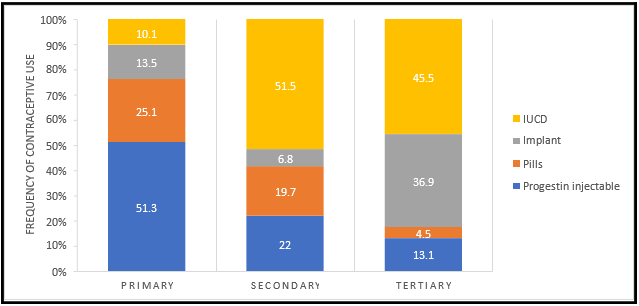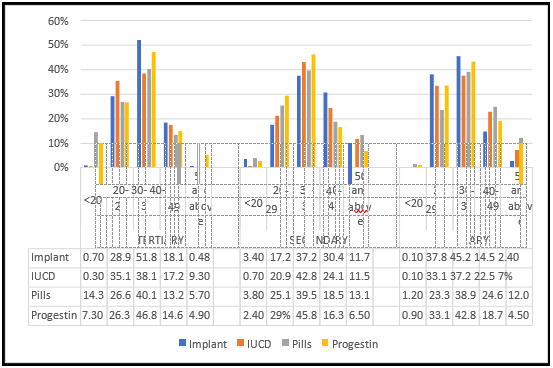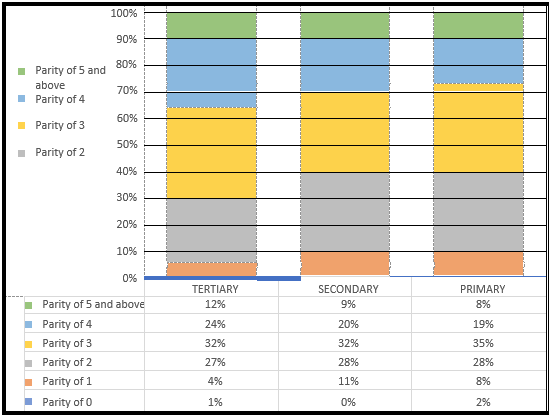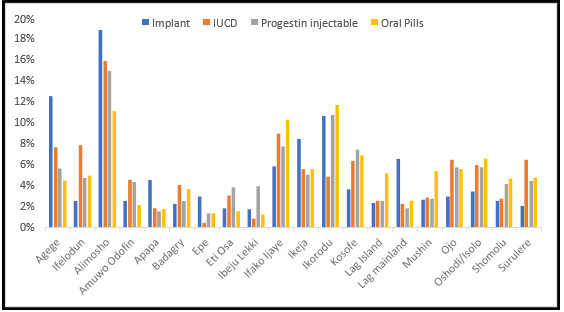Oluyemi Akinloye1,2*, Isaac Adediji1, 2, Titilola A. Samuel3, Olayiwola Popoola2, Bolanle O. Iranloye4, Ayo O. Arowojolu5
1Chemical Pathology Unit, Department of Medical Laboratory Science, Faculty of Public Health, Babcock University, Ilishan Remo, Ogun State
2Clinical Chemistry and Molecular Diagnosis Laboratory, Department of Medical Laboratory Science
3Department of Biochemistry, Faculty of Basic Medical Sciences, College of Medicine, University of Lagos, Lagos State
4Department of Physiology, Faculty of Basic Medical Sciences, College of Medicine, University of Lagos, Lagos State
5Department of Obstetrics and Gynaecology, Faculty of Clinical Sciences, College of Medicine, University of Ibadan, Oyo State, Nigeria
*Corresponding Author: Oluyemi Akinloye, Department of Medical Laboratory Science Faculty of Basic Medical Sciences College of Medicine of the University of Lagos
Abstract
Background: Nigeria's population continues to grow at a fast rate despite the presumed increase in the use of contraceptives. Appropriate strategies and policies that will contribute to better coverage may arise from reviewing current trends.
Objectives: To determine the trend of contraceptive use among women attending family planning clinics in selected facilities in the southwestern part of Nigeria from 2007 to 2017.
Methods: This is a retrospective study of women who accessed family planning services from the selected primary, secondary, and tertiary health care facilities in the southwestern part of Nigeria between 2007 and 2017. Information related to their age, parity, and method of contraceptives were obtained using a standardized proforma. Data were analyzed using SPSS Version 17.0 (SPSS Inc., Chicago, IL, USA) statistical package.
Results: During the 10-year review period, the majority of the clients that assessed family planning services at the selected secondary and tertiary healthcare institutions opted for IUCD, accounting for 51.5 % and 45.5 %, respectively, whereas, at the selected primary healthcare centers, progestin injectable was the most popular (51.3 %). Women within the age range of 30-39 years and those having two and three parity are more likely to use modern contraceptive methods in Nigeria.
Conclusions: We observed apparent variations in the pattern of contraceptive use in primary, secondary, and tertiary health care facilities. Population settings rather than accessibility and availability of modern contraceptive methods appear to determine the choice and pattern of contraceptive use. There may be a need to devise strategies and policies to help meet specific contraceptive needs of clients in different population settings.
Keywords: Retrospective review, Family planning, Modern contraceptives, Nigeria
Introduction
Currently, a crucial aspect of targets for global access to sexual and reproductive health is family planning, and this is enshrined in the sustainable development goals 3 and 5 reviewed by Barot et al. [1] and Dockalova et al. [2]. Family planning is the practice that allows the couple to have their desired number of children and determine the spacing between their births utilizing contraception. This practice is being promoted globally to address the reproductive health concerns of families and to control the rapid population increase [3].
The fertility rate in Sub-Saharan Africa is one of the highest in the world, and this may be due to decreased adoption of modern birth control. Generally, high birth, which translates into a high population, engenders numerous problems for a nation's economic growth and development. In Nigeria, the rate of fertility is about 5.7 children per woman [4], and this has accounted for the rapid increase in the current population of the country, estimated to be about 180 million, this is expected to reach 338 million by the year 2050 if the rapid population explosion is not controlled [4-6]. Despite the rapid population growth in Nigeria, contraceptives use among women of reproductive age is deficient, as the country ranks 152 on the 2014 human development index [5].
Nigeria is ranked second among the countries known to have the highest number of maternal mortalities as approximately 60,000 women die each year and about 40 % of these deaths are due to unintended pregnancies and complications arising from clandestine and unsafe abortions [5-7]. Similarly, according to Nigeria Demographic and Health Survey (NHDS) in 2013, only 15 % of married women between the ages of 15-49 use contraceptives in Nigeria, which are just about a 2 percent increase in the percentage points from the 2003 NHDS report. The prevalence rate of modern contraceptive use among Nigerian women of reproductive age, based on geopolitical zones, ranges from almost no use in the north-east to 2.7 % in the north-west, 32.6 % in the south-east, and 28.5 % in the south-west [5,10]. However, more than this proportion would have adopted modern contraceptive methods if they were readily available, and lack of access has made many women rely upon traditional methods, which are less effective [11]. Besides lack of access as part of barriers encountered by these women, other factors are lack of adequate public awareness, myths and cultural factors, religion, opposition to the use by partners or family members, fear of potential risks, and side effects [11-12].
Canning and Schultz (2012) opined that developing countries' economies would improve with modern birth control methods [13]. Therefore, contraception is considered a vital tool required to reduce poverty and hunger, reduce maternal mortality, protect families against unwanted pregnancies and empower couples to make better family choices.
This study aims to review the trend of contraceptive use among women attending family planning clinics of selected health facilities in the southwestern part of Nigeria. This data will provide information for evidence-based policy for the next decade of contraceptive usage in the study population.
Subjects and Methods
The health facilities selected for this study represent Nigeria's three tiers of healthcare delivery systems, i.e., the primary, secondary and tertiary healthcare delivery systems. The convenience sampling method used in this study focused on the centers with the most significant numbers of clients in the Southwest. The selected health facilities are prominent and centrally located in three different states in the southwestern region of Nigeria. The primary health care centers (PHCs) are located in Lagos State with a clear enumerated area for easy access to retrospective data. The selected secondary and tertiary health institutions are in Ijebu-Ode, Ogun State, and Ibadan, Oyo State, respectively. These allow the spread of data across significant cities in Southwestern Nigeria. In addition, the University of Ibadan has the highest volume of family clinics in these regions. With the aid of a structured proforma, this retrospective study obtained information about age and choice of contraceptive from the record of women who attended the family planning clinics of these health facilities between 2007 and 2017. This decade's data were the homogeneous and consistence data before the interruption by COVID 19 pandemic in 2019. Data were analyzed using SPSS Version 17.0 (SPSS Inc., Chicago, IL, USA) statistical package, and results were presented as frequencies and percentages. Chi-square was used to demonstrate the relationship between variables.
Results
The most commonly adopted modern methods of contraception available at the selected health care institutions include Progestin-only injectable, combined oral contraceptive pills (Pills), Copper T- Intrauterine Contraceptive Device (IUCD), and implants. At the tertiary health care institution in Ibadan, Oyo State, 7,795 women attended the family planning clinic during the period under review. Moreover, at the secondary health care institution in Ijebu Ode, Ogun state, 4,249 women participated in the family planning clinic during this period under review. Meanwhile, 906,796 visited the family planning clinics of the selected primary health care institutions in Lagos State during the period under review.
The proportion of uptake and percentage for the contraceptive options obtained at the selected health care institutions between 2007 and 2017 are shown in Table 1 and Figure 1. At the chosen tertiary health care institution, IUCD was the most popular, accounting for 45.5 % of the clients that assessed family planning service; this is followed by implants (36.9 %), then progestin injectable (13.1 %) and oral contraceptive pills (4.5 %). Also, at the selected secondary health care institution, IUCD was the most popular; 51.5% of the clients that assessed family planning service at this center opted for this method and this is followed by progestin injectable (22 %), then pills (19.7 %) and implant (6.8 %). Meanwhile, at the primary health care center, the use of progestin injectable (51.3 %) was the most popular, and this is followed by pills (25.1 %), then IUCD (13.5 %), and implant (10 %). Table 1 also shows a statistically significant difference in contraceptive options between the selected three tiers of health care institutions.
Table 1: Contraceptive options and frequency of uptake in all selected health care facilities between 2007 and 2017
|
Contraceptives |
Primary |
Secondary |
Tertiary |
P |
|
Progestin injectable |
464,884 (51.3 %)a, c |
934 (22.0 %)b, c |
1025 (13.1 %)a, b |
< 0.001 |
|
Pills |
227,329 (25.1 %)a, c |
835 (19.7 %)b, c |
349 (4.5 %)a, b |
< 0.001 |
|
Implant |
122,431 (13.5 %)a, c |
290 (6.8 %)b, c |
2,878 (36.9 %)a, b |
< 0.001 |
|
IUCD |
92,152 (10.1 %)a, c |
2190 (51.5 %)b, c |
3543 (45.5 %)a, b |
< 0.001 |
asignificantly different from secondary, b significantly different from primary, c significantly different from tertiary.
Figure 1: Pattern and trend of contraceptive use at different tiers of health care services in Southwestern part of Nigeria, between 2007 and 2017
As shown in Figure 2, in all the selected centers, most of the contraceptive users were between 30 and 39 years old. During the period under review, the use of implants was the most popular among clients within the age range of 30 and 39 years at both primary health care and tertiary health care institutions (45.2 % and 51.8 %, respectively) while injectable progestin (45.8 %) was the most popular among the clients at the secondary health care institution. The parity of clients that assessed family planning services at the three tiers of health care institutions during the period under review is presented in Figure 3. In all the centers, most contraceptive users had a parity of 3.
The frequency of contraceptive use at the different primary health care centers in Lagos State is shown in Table 2 and Figure 4. During the period under review, the highest proportion of contraceptive use (14.5 %) was found at the primary health care centers in the Alimosho local government area of Lagos State.
Table 2: Proportion of contraceptive use at the PHCs in different enumerated local government area of Lagos State
|
LGAs |
Implant |
IUCD |
Progestin injectable |
Oral Pills |
Total |
|
Agege |
15250 |
6978 |
25836 |
10069 |
58133 (6.4 %) |
|
Ifelodun |
3105 |
7202 |
21983 |
11071 |
43361 (4.8 %) |
|
Alimosho |
23039 |
14537 |
69199 |
24939 |
131714 (14.5 %) |
|
Amuwo Odofin |
3028 |
4108 |
19762 |
4800 |
31698 (3.5 %) |
|
Apapa |
5505 |
1695 |
6945 |
3756 |
17901 (2.0 %) |
|
Badagry |
2702 |
3670 |
11651 |
8248 |
26271 (2.9 %) |
|
Epe |
3589 |
379 |
6100 |
2844 |
12912 (1.4 %) |
|
Eti Osa |
2096 |
2767 |
17634 |
3412 |
25909 (2.9 %) |
|
Ibeju Lekki |
2070 |
726 |
18095 |
2829 |
23720 (2.6 %) |
|
Ifako Ijaye |
7144 |
8241 |
35717 |
23175 |
74277 (8.2 %) |
|
Ikeja |
10255 |
5076 |
23267 |
12607 |
51205 (5.6 %) |
|
Ikorodu |
12949 |
4379 |
49963 |
26437 |
93728 (10.3 %) |
|
Kosofe |
4438 |
5674 |
33784 |
15419 |
59315 (6.5 %) |
|
Lagos Island |
2794 |
2306 |
11598 |
11556 |
28254 (3.1 %) |
|
Lagos Mainland |
7994 |
2062 |
8559 |
5710 |
24325 (2.7 %) |
|
Mushin |
3192 |
2703 |
12611 |
12109 |
30615 (3.4 %) |
|
Ojo |
3574 |
5871 |
25757 |
12490 |
47692 (5.3 %) |
|
Oshodi/Isolo |
4115 |
5436 |
26687 |
14781 |
51019 (5.6 %) |
|
Shomolu |
3109 |
2470 |
19292 |
10484 |
35355 (3.9 %) |
|
Surulere |
2483 |
5872 |
20444 |
10593 |
39392 (4.3 %) |
|
Total |
122431 |
92152 |
464884 |
227329 |
906796 |
Figure 2: Age distribution of contraceptive users in the selected three tiers of health care services in Southwestern part of Nigeria, between 2007 and 2017
Figure 3: Parity of contraceptive users in the selected three tiers of health care services in Southwest, Nigeria between 2007 and 2017
Figure 4: Pattern and trend of contraceptive use at the selected primary health care centres in Lagos State between 2007 and 2017
Discussion
This study highlights the trend of contraceptive use at the three tiers of Nigeria's health care delivery system between 2007 and 2017. The findings of this study indicated apparent variations in the pattern of contraceptives at the selected three tiers of health care services. This observation could be attributed to the population settings of the regions chosen for this study. Lagos State has the largest population in Nigeria, approximately 11.8 million; Ibadan has about 2 million inhabitants, while Ijebu Ode has a population of 222,653 [14]. Moreover, the highest proportion of contraceptive users are found in the most populous region of Lagos State (Alimosho LG). This region is known to have approximately 2 million inhabitants.
Furthermore, from the available modern contraceptive methods at both tertiary and secondary health care institutions, the most popular contraceptive of choice was IUCD, accounting for 45.5 % and 51.5 %, respectively. Several studies from various centers in Nigeria reported a similar observation about using IUCD. It was written by several studies from multiple centers in Nigeria, and it has been estimated that over 130 million women of reproductive age use IUCD for birth control [15-17]. Meanwhile, the most popular contraceptive of choice at the primary health care institution was progestin injectable (51.3 %). This is in contrast to a study conducted between 2010 and 2012 at Lagos University Teaching Hospital that reported using implants as the most common contraceptive method [18]. This observation is also a variant of IUCD most used in a tertiary hospital in Ibadan, University College Hospital. The disparity observed by this study may be due to the diversity of population setting and cost variation rather than variation in the type of available contraceptive methods since all the reported practices of contraceptives are readily available in all the study populations. Furthermore, it could be that clients came with their minds made up concerning the methods they would use, having been influenced by other factors such as experiences of their friends.
In this study, the majority of women patronizing modern contraceptives from all the selected health facilities were within the age range of 30-39 years. This is similar to the trend observed by NHDS in 2013, with increased contraceptive use by those within the age range of 30-39 years and a decline in the uptake by those within the age range of 45-49 years [10]. This is also similar to the observation of Ijarotimi et al. (2015), who opined that most Nigerian women within the age range of 30-39 years are at the peak of their childbearing period, and they delay childbirth to their early 30s, possibly because they do not want the challenge of raising children to conflict with their career advancement15. Furthermore, we observed increased use of contraceptives with parity of three. NHDS reported a similar observation in 2013, and there was a decline in the use of contraceptives among women without children (2 %), while an increase in the service was observed among women with three and four children (21%) [10]. This suggests that women with parity below three are at the peak of their childbearing period and would not want to consider using any contraceptive method until they have had their desired family size.
Conclusions
Population settings appear to determine the choice and pattern of contraceptive use rather than the accessibility and availability of modern contraceptive methods. Therefore, strategies and policies that would help meet specific contraceptive needs of clients in different population settings are necessary. Generally, the percentage of women patronizing modern contraceptives is still comparatively low compared to the total population. There may therefore be a need to intensify efforts across the different states in Nigeria to increase women’s use of family planning services to minimize maternal mortality and the problem of overpopulation.
Acknowledgment: The authors thank the management and staff of the health facilities used in this study for their kind assistance. The study did not receive any funding.
Ethical Statement: All authors declare that this study was approved by the Lagos State Primary Health Care Board (LS/PHCB/MS/1128/VOL III/039) and has been performed by the ethical standards laid down in the 1964 Declaration of Helsinki.
References
- Barot S, Cohen S, Darroch J, Galati A.J, Polis C, et al. (2015) Sexual and reproductive health and rights indicators for SDGs. Recommendations for inclusion in the sustainable development goals and post-2015 development process.
- Dockalova B, Lau K, Barclay H and Marshall A. Sustainable Development Goals and family planning 2016.
- UNFPA 2014. State of the World Population Report.
- Adebimpe WO, Asekun-Olarinmoye EO (2012) A comparative study of contraceptive use among rural and urban women in Osun State, Nigeria. Int J Trop Dis Heal. 2(3): 214–224.
- Hounton S, Barros AJ, Amouzou A, Shiferaw S, Maïga A, et al. (2015) Patterns and trends of contraceptive use among sexually active adolescents in Burkina Faso, Ethiopia and Nigeria: evidence from cross-sectional studies. Global Health Action. 8(1): 29737.
- Adeyemi A, Olugbenga-Bello AI, Adeoye O, Salawu M, Aderinoye A, et al. (2016) Contraceptive prevalence and determinants among women of reproductive age group in Ogbomoso, Oyo State, Nigeria. Open Access Journal of Contraception. 7: 33-41.
- Omo-Aghoja LO, Omo-Aghoja VW, Aghoja CO, Okonofua FE, Aghedo O, et al. (2009) Factors Associated With the Knowledge, Practice and Perceptions of Contraception in Rural Southern Nigeria. Ghana Medical Journal. 43(3): 115–121.
- Mojekwu JN, Ibekwe U (2012) Maternal mortality in Nigeria: examination of intervention methods. International Journal of Humanities and Social Science. 2(20): 1-15.
- Akokuwebe ME, Okafor EE (2015) Maternal Health and the Implications for Sustainable Transformation in Nigeria. Research on Humanities and Social Sciences. 5(6): 1-14
- Nigeria Demographic and Health Survey 2013. National Population Commission (NPC) [Abuja, Nigeria] and ICF International [Rockville, Maryland, USA]; 2014.
- Carr D, Khan M. The Unfinished Agenda: Meeting the needs for family planning in less developed countries. Washington. DC: 2004. 4366,567(34)
- Cleland JG, Ndugwa RP, Zulu EM (2011) Family planning in sub- Saharan Africa: progress or stagnation? Bull World Health Organ. 89(2): 137-43.
- Canning D, Schultz P (2012) The economic consequences of reproductive health and family planning. Lancet. 380(9837): 165- 171.
- National Population Commission. 2006. Final results of 2006 population census of Nigeria.
- Ijarotimi Adebimpe O, Bakare B, Badejoko OO, Fehintola AO, Loto OM, et al. (2015) Contraceptive uptake among women attending family planning clinic in a Nigerian tertiary health facility: a 6 year review. Int J Reprod Contracept Obstet Gynecol. 4(3): 721-724.
- Foran TM (2003) New contraceptive choices across reproductive life. Med J Aust. 178(12): 616-20.
- Herbert B, Peterson HB, Curtis KM (2003) Contraception. In: James R. Scott, Ronald S. Gibbs, Beth Y. Karlan, Arthur F. Haney, eds. Danforth’s Obstetrics and Gynaecology. 9th ed. Philadelphia: Lippincott Williams & Wilkins Publishers. 2003: 37.
- Okunade K, Daramola E, Ajepe A, Sekunade A (2017) A 3-year review of the pattern of contraceptive use among women attending family planning clinic of a university teaching hospital in Lagos, Nigeria. African J.Med.H. 15(2): 69-73.







